يوضّح لك هذا الدليل كيفية استخدام "SDK لإعلانات Google على الأجهزة الجوّالة" من أجل تحميل الإعلانات وعرضها من Chartboost باستخدام التوسّط، مع تغطية عمليات الدمج المتسلسلة. توضّح هذه الصفحة كيفية إضافة Chartboost إلى إعدادات التوسّط الخاصة بوحدة إعلانية، وكيفية دمج حزمة تطوير البرامج (SDK) ومحوّل Chartboost في تطبيق Android.
عمليات الدمج وأشكال الإعلانات المتوافقة
يتضمّن وسيط الإعلانات في Chartboost الإمكانات التالية:
| التكامل | |
|---|---|
| عروض الأسعار | |
| عرض إعلاني بدون انقطاع | |
| التنسيقات | |
| بانر | |
| إعلان بيني | |
| مقابل مكافأة | |
| مدمج مع المحتوى | |
المتطلبات
- المستوى 23 من واجهة برمجة التطبيقات Android أو مستوى أعلى
أحدث إصدار من حزمة "SDK لإعلانات Google على الأجهزة الجوّالة"
إكمال دليل البدء الخاص بالتوسّط
الخطوة 1: ضبط الإعدادات في واجهة مستخدم Chartboost
اشترِك في حساب على Chartboost وسجِّل الدخول بعد تأكيد حسابك. بعد ذلك، انتقِل إلى علامة التبويب إدارة التطبيقات.
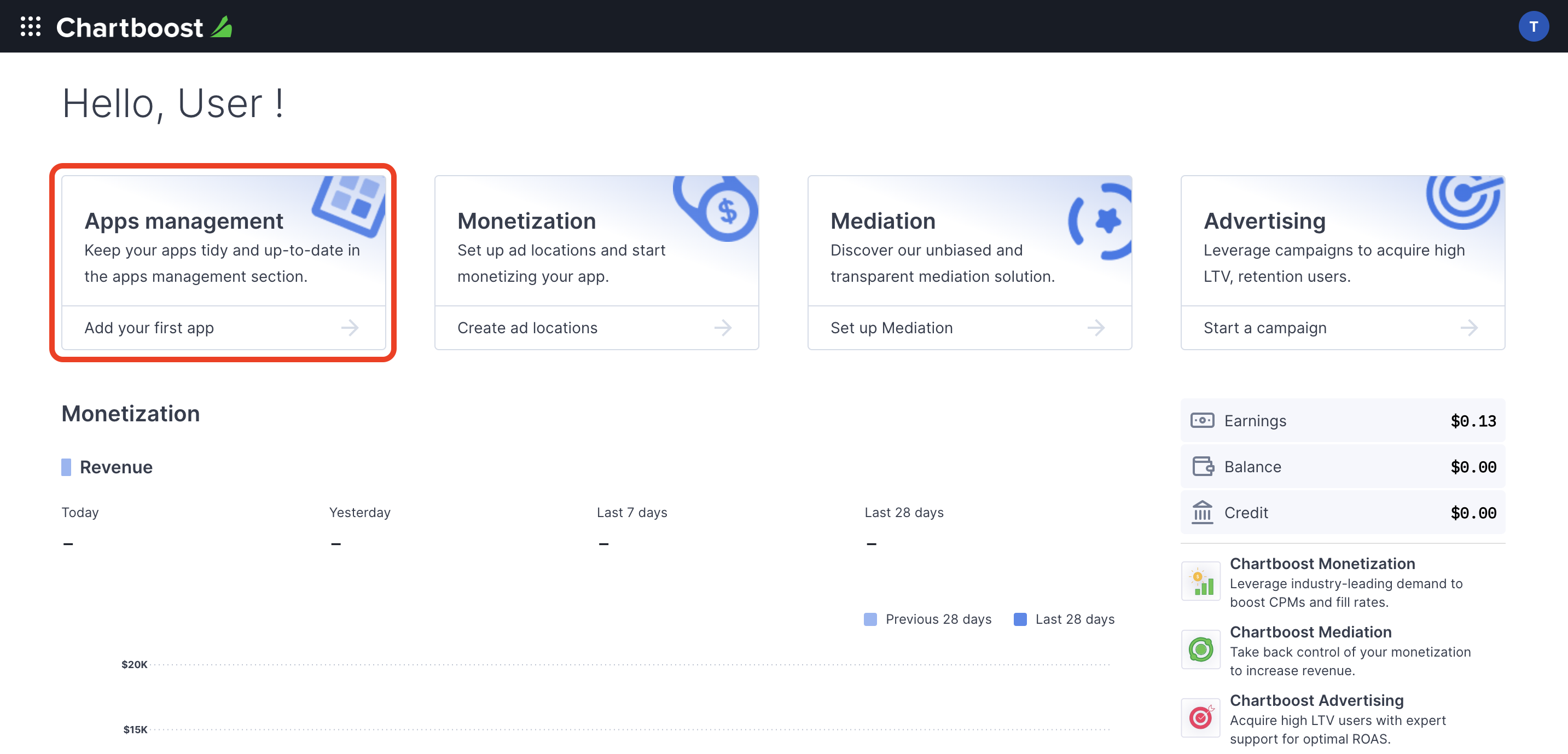
انقر على الزر إضافة تطبيق جديد لإنشاء تطبيقك.
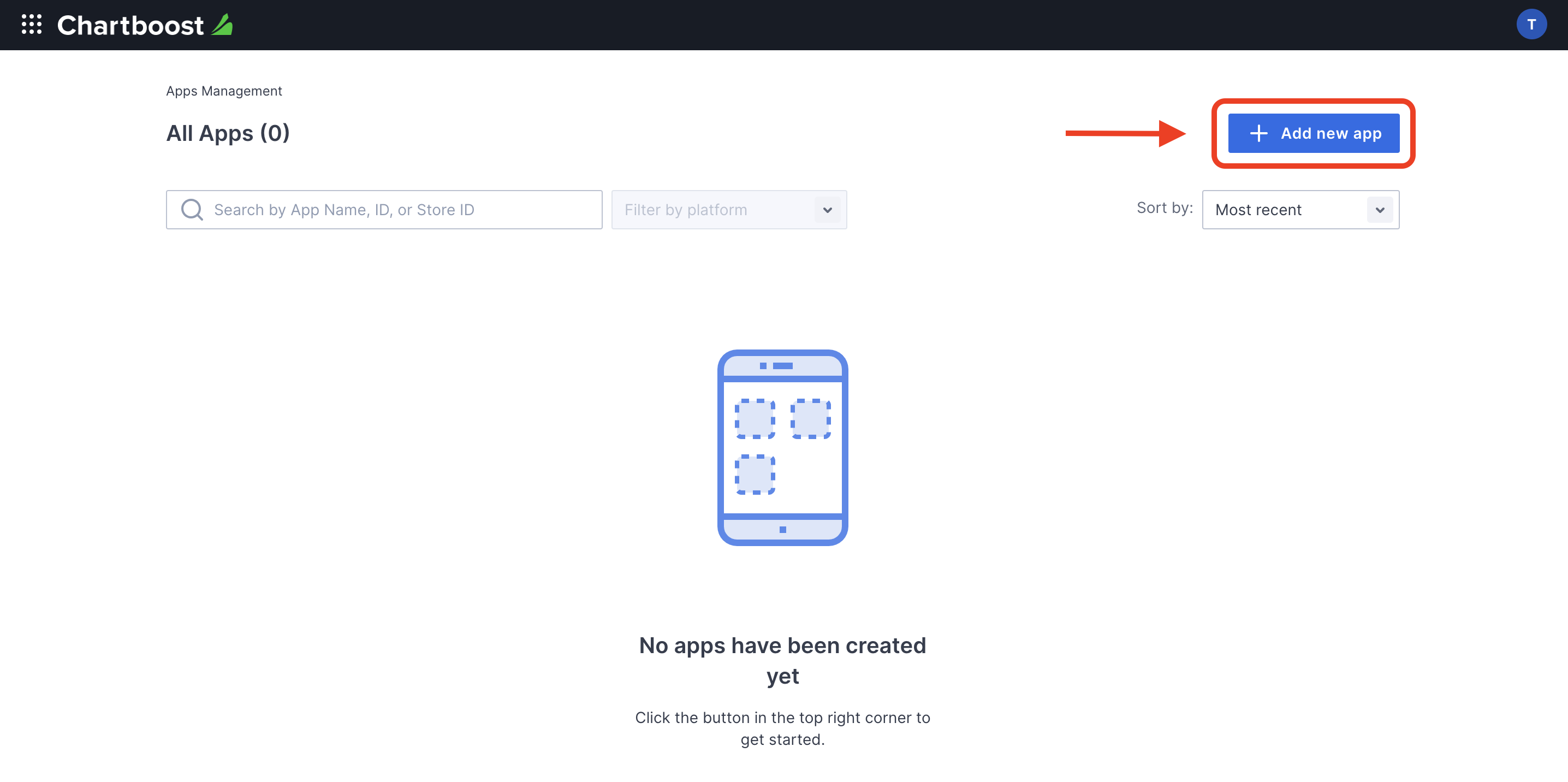
املأ بقية النموذج وانقر على الزر إضافة تطبيق لإنهاء عملية إنشاء تطبيقك.

بعد إنشاء تطبيقك، سيتم توجيهك إلى لوحة البيانات الخاصة به. دوِّن رقم تعريف التطبيق وتوقيع التطبيق.
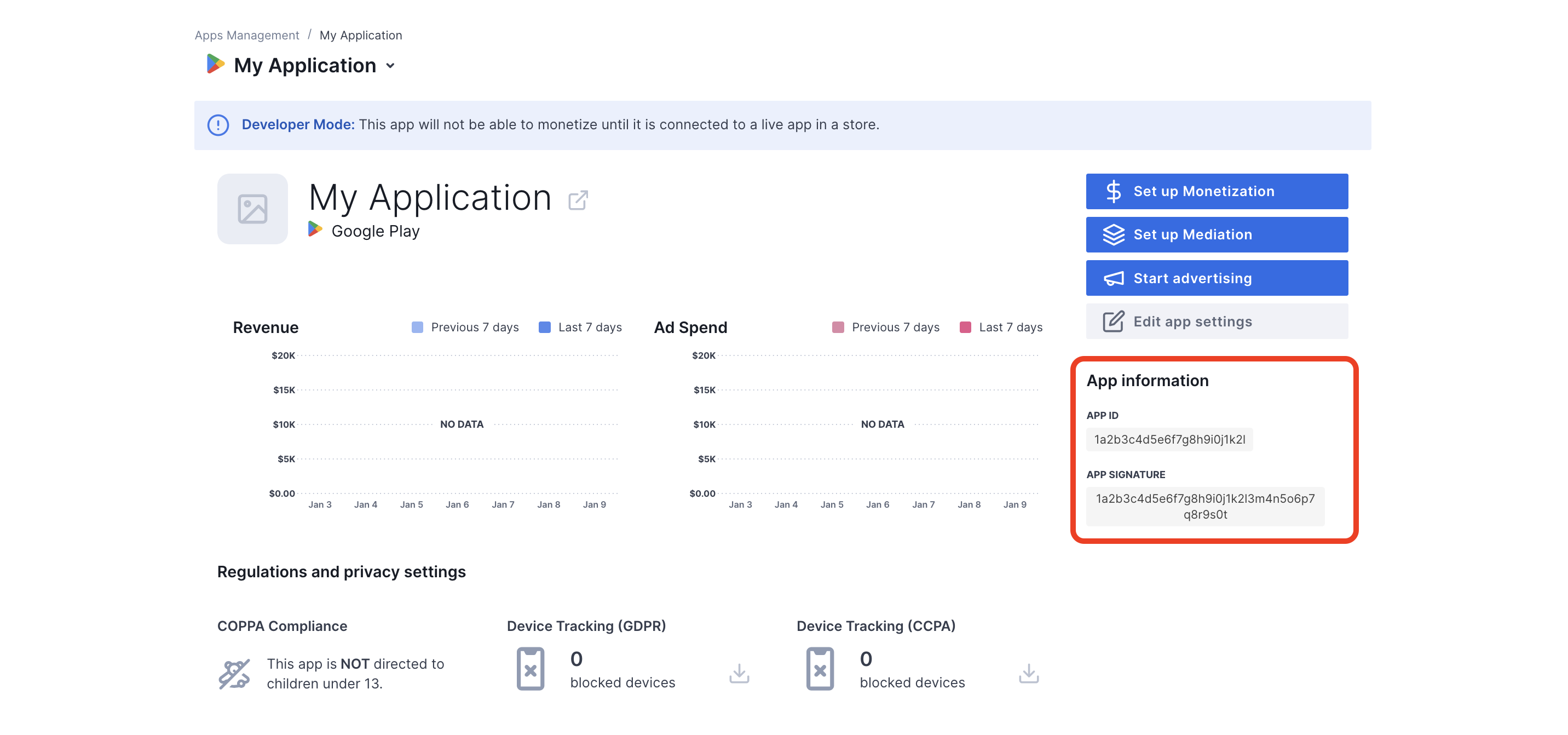
تتطلّب "إدارة إعلانات Google" معرّف المستخدم وتوقيع المستخدم من Chartboost لإعداد رقم تعريف الوحدة الإعلانية في "إدارة إعلانات Google". يمكنك العثور على هذه المَعلمات من خلال النقر على التوسّط في Chartboost في واجهة مستخدم Chartboost.

انتقِل إلى علامة التبويب المراجع > مستكشف واجهة برمجة التطبيقات واحتفِظ بمعرّف المستخدم وتوقيع المستخدم ضمن قسم المصادقة.
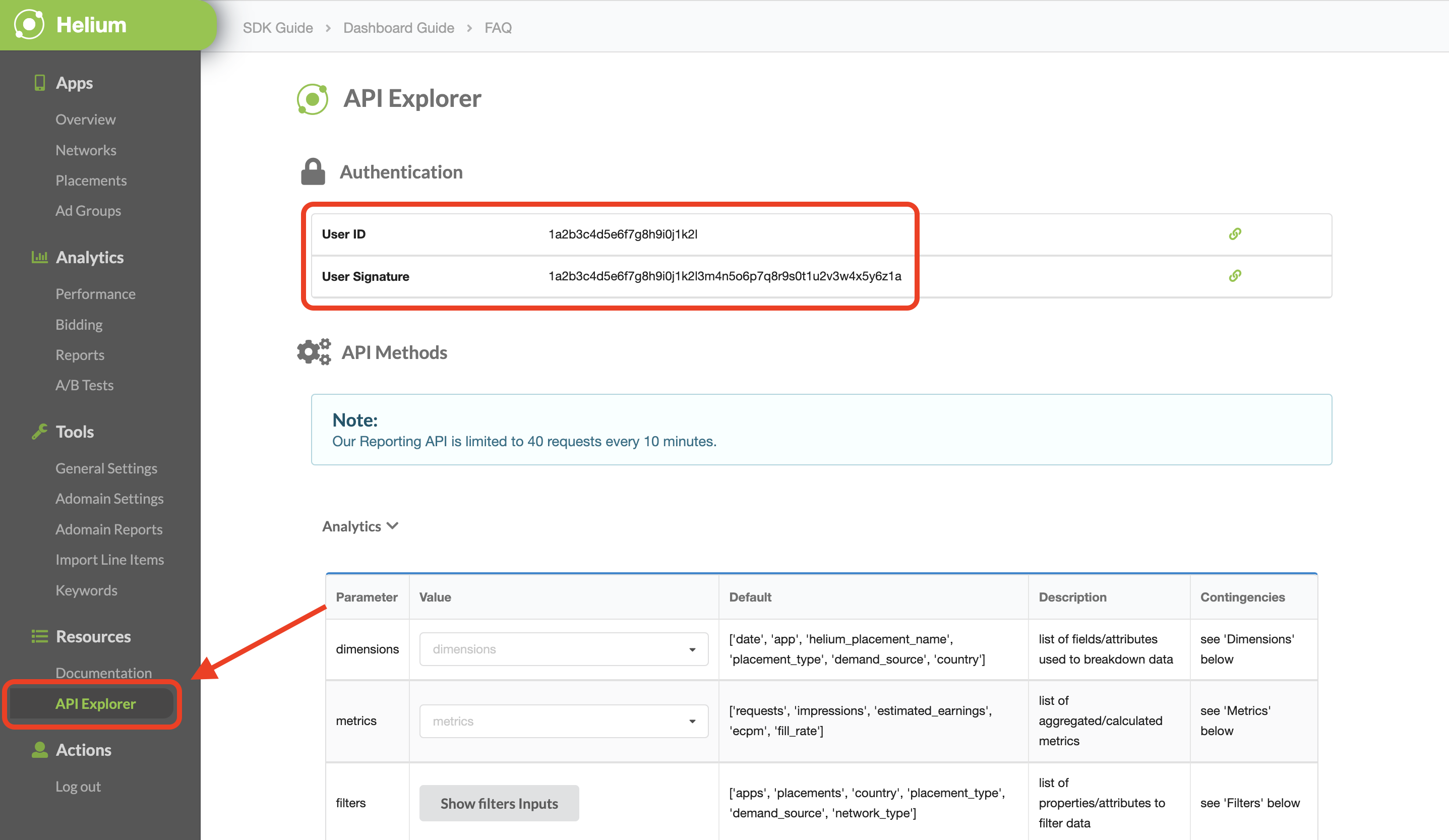
تعديل ملف app-ads.txt
مبادرة "البائعون المعتمَدون للتطبيقات" أو ملف app-ads.txt هي مبادرة من "مختبر IAB التقني" تساعد على ضمان عدم بيع المساحة المتوفّرة للإعلانات في تطبيقك سوى من خلال القنوات التي حدَّدت أنّها مخوّلة. لتجنُّب حدوث خسائر كبيرة في إيرادات الإعلانات، عليك استخدام ملف app-ads.txt.
إذا لم يسبق لك إجراء ذلك،
أنشئ ملف app-ads.txt لـ "مدير إعلانات Google".
لتنفيذ app-ads.txt في Chartboost، يُرجى الاطّلاع على
app-ads.txt.
تفعيل وضع الاختبار
يمكنك تفعيل وضع الاختبار في تطبيقك من خلال الانتقال إلى علامة التبويب إدارة التطبيقات من واجهة مستخدم Chartboost، واختيار تطبيقك من القائمة، ثم النقر على تعديل إعدادات التطبيق.
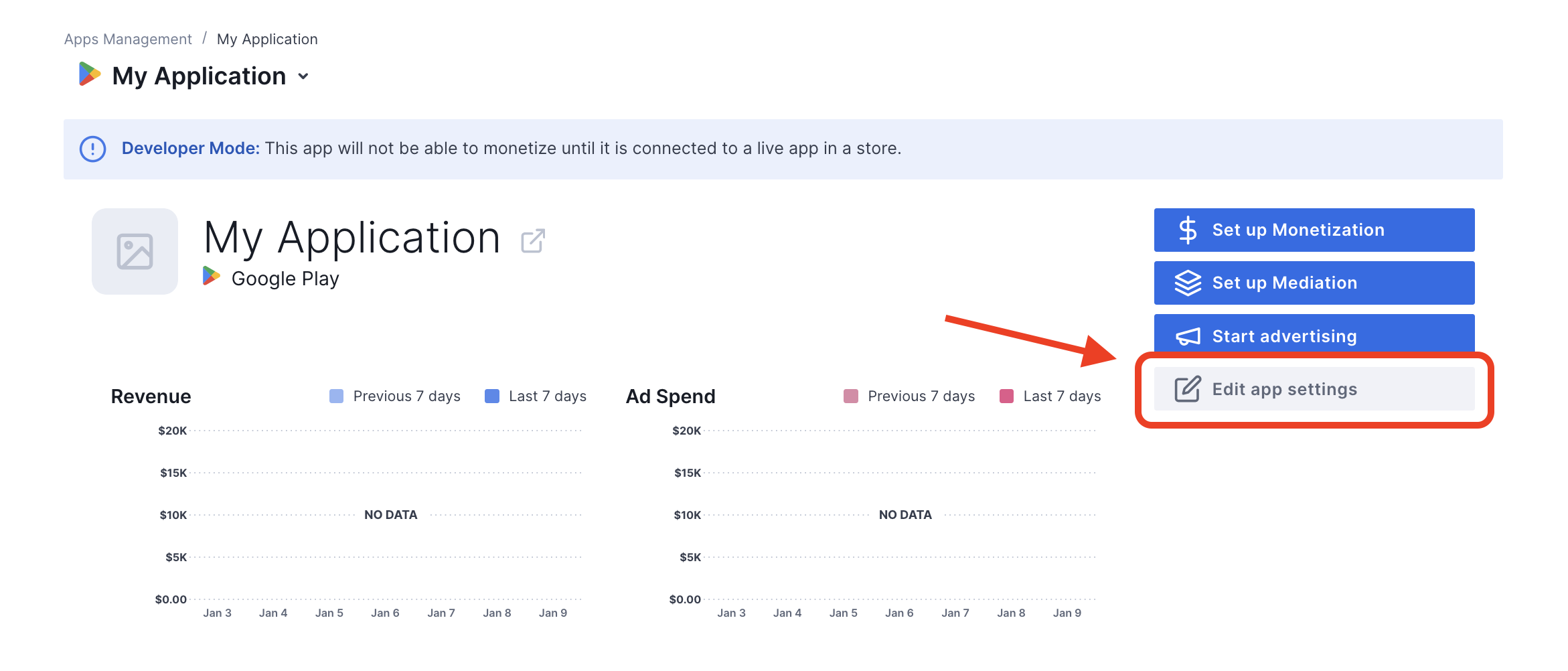
من إعدادات تطبيقك، يمكنك تفعيل وضع الاختبار في تطبيقك أو إيقافه.
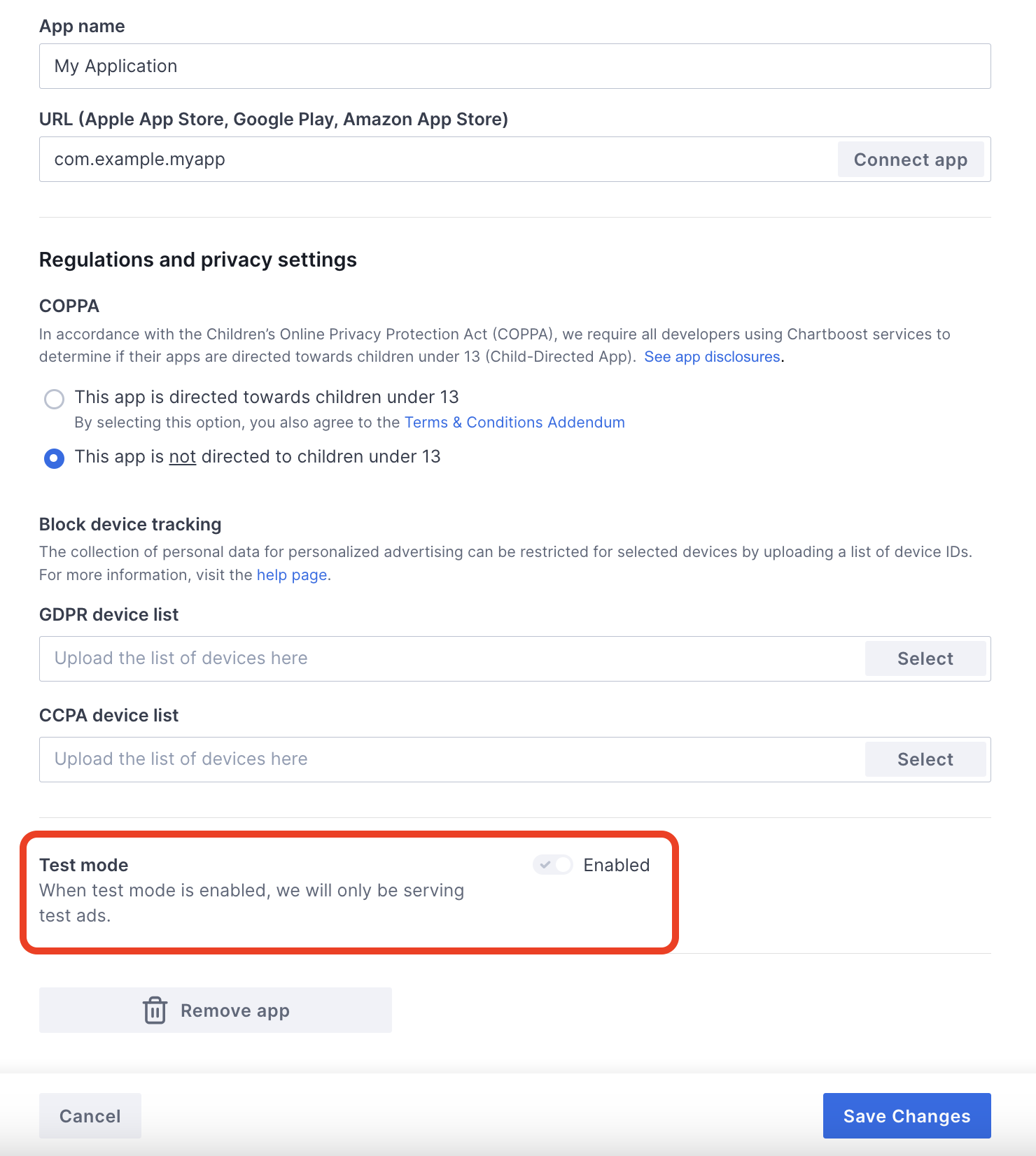
بعد تفعيل وضع الاختبار، يمكنك طلب إعلانات باستخدام معرّف الوحدة الإعلانية الذي تم إنشاؤه سابقًا وتلقّي إعلان اختباري من Chartboost.
بعد أن يصبح بإمكانك تلقّي إعلانات اختبارية من Chartboost، سيتم إدراج تطبيقك في مراجعة تطبيقات الناشرين على Chartboost. لكي يتم تحقيق الربح على Chartboost، يجب أن توافق Chartboost على مراجعة تطبيق الناشر.
الخطوة 2: إعداد طلب Chartboost في واجهة مستخدم "إدارة الإعلانات"
ضبط إعدادات التوسّط للوحدة الإعلانية
سجِّل الدخول إلى حسابك على "مدير إعلانات Google".
انتقِل إلى التسليم > مجموعة الشبكات الإعلانية المدِرّة للأرباح وانقر على الزر مجموعة شبكات إعلانية مدِرّة للأرباح جديدة.
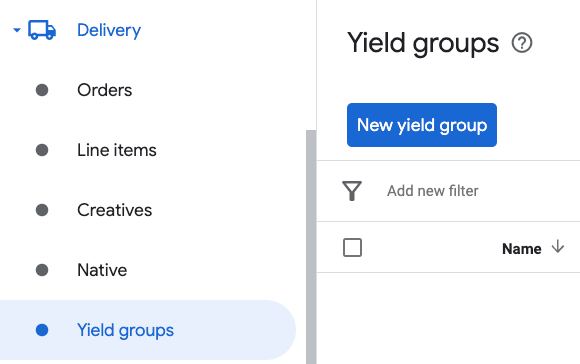
أدخِل اسمًا فريدًا لمجموعة الشبكات الإعلانية المدِرّة للأرباح، واضبط الحالة على نشطة، واختَر شكل الإعلان، واضبط نوع المساحات الإعلانية المتاحة على تطبيق على الأجهزة الجوّالة. ضمن قسم الاستهداف > المساحات الإعلانية المتاحة، اختَر الوحدة الإعلانية ضمن المساحات الإعلانية المتاحة وتطبيق الأجهزة الجوّالة الذي تريد إضافة التوسّط إليه.
بعد ذلك، انقر على الزر إضافة شريك إعلاني مدِّر للأرباح.

إذا كان لديك شريك إعلاني مدِّر للأرباح في Chartboost، يمكنك اختياره. بخلاف ذلك، اختَر إنشاء شريك جديد إعلاني مدِّر للأرباح.
اختَر Chartboost كـ شبكة إعلانية، وأدخِل اسمًا فريدًا وفعِّل التوسّط.
فعِّل جمع البيانات تلقائيًا، وأدخِل معرّف المستخدِم وتوقيع المستخدِم الذي حصلت عليهما في القسم السابق.

بعد اختيار شريك إعلاني مدِّر للأرباح، اختَر التوسّط في حزمة تطوير البرامج (SDK) للأجهزة الجوّالة كـ نوع الدمج، وAndroid كـ النظام الأساسي، ونشط كـ الحالة. أدخِل معرّف التطبيق وتوقيع التطبيق وموقع الإعلان التي حصلت عليها في القسم السابق. بعد ذلك، أدخِل قيمة تكلفة تلقائية لكل ألف ظهور.
مواقع إعلانات Chartboost (المواقع المسماة) هي أسماء بسيطة تمثّل مكانًا في تطبيقك تريد عرض إعلان فيه. يرسل "مدير إعلانات Google" الطلبات إلى الموقع الجغرافي المحدّد في الإعدادات. بعد إرسال الطلبات، ستضيف Chartboost الموقع الجغرافي إلى واجهة المستخدم لأغراض إعداد التقارير.
في واجهة مستخدم Chartboost، يمكن الكشف عن "مواقع الإعلانات" في صفحة الإعدادات الأساسية من خلال النقر على الإعدادات المتقدّمة. اطّلِع على دليل المواقع الجغرافية المسماة في Chartboost للحصول على مزيد من التفاصيل.
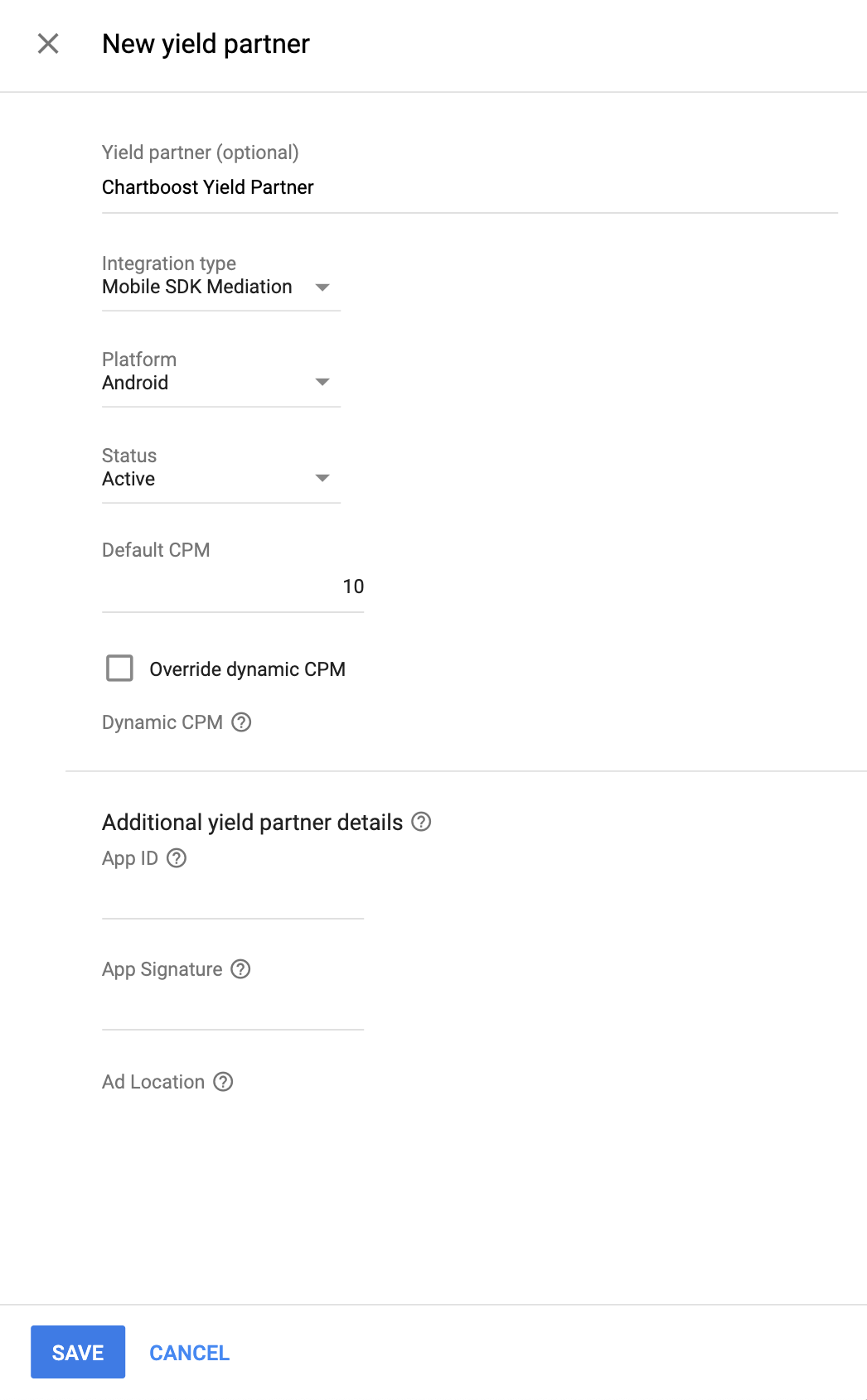
انقر على حفظ في أسفل الصفحة عند الانتهاء.
إضافة Chartboost إلى قائمة شركاء الإعلانات بموجب اللائحة العامة لحماية البيانات (GDPR) واللوائح التنظيمية في الولايات الأمريكية
اتّبِع الخطوات الواردة في إعدادات اللوائح التنظيمية الأوروبية و إعدادات اللوائح التنظيمية في الولايات الأمريكية لإضافة Chartboost إلى قائمة الشركاء الإعلانيين بموجب اللوائح التنظيمية الأوروبية ولوائح الولايات الأمريكية في واجهة مستخدم "مدير إعلانات Google".
الخطوة 3: استيراد حزمة تطوير البرامج (SDK) ومحوّل Chartboost
دمج Android Studio (يُنصح به)
في ملف settings.gradle.kts على مستوى المشروع، أضِف المستودعات التالية:
dependencyResolutionManagement {
repositories {
google()
mavenCentral()
maven {
url = uri("https://cboost.jfrog.io/artifactory/chartboost-ads/")
}
}
}
بعد ذلك، في ملف build.gradle.kts على مستوى التطبيق، أضِف تبعيات التنفيذ والإعدادات التالية. استخدِم أحدث إصدارات من حزمة تطوير البرامج (SDK) والمحوّل الخاصَين بشبكة Chartboost:
dependencies {
implementation("com.google.android.gms:play-services-ads:24.9.0")
implementation("com.google.ads.mediation:chartboost:9.10.2.0")
}
الدمج اليدوي
نزِّل ملف
.aarالخاص بأحدث إصدار من Chartboost SDK من Maven Central، وأضِفه إلى مشروعك.انتقِل إلى عناصر محوّل Chartboost في مستودع Maven من Google. اختَر أحدث إصدار، ونزِّل ملف
.aarالخاص بمحوّل Chartboost، وأضِفه إلى مشروعك.
الخطوة 4: تنفيذ إعدادات الخصوصية على حزمة تطوير البرامج (SDK) من Chartboost
موافقة المستخدمين في الاتحاد الأوروبي و"اللائحة العامة لحماية البيانات"
للامتثال لسياسة موافقة المستخدم في الاتحاد الأوروبي المتّبعة في Google، عليك تقديم إفصاحات معيّنة للمستخدمين في المنطقة الاقتصادية الأوروبية والمملكة المتحدة وسويسرا، والحصول على موافقتهم على استخدام ملفات تعريف الارتباط أو غيرها من وسائل التخزين المحلية حيثما كان ذلك مطلوبًا قانونًا، وعلى جمع البيانات الشخصية ومشاركتها واستخدامها لتخصيص الإعلانات. تراعي هذه السياسة متطلبات "التوجيه الأوروبي بشأن الخصوصية الإلكترونية" و"اللائحة العامة لحماية البيانات" (GDPR). أنت المسؤول عن التأكّد من نقل حالة الموافقة إلى كل مصدر إعلان في سلسلة التوسّط. ولا يمكن لشركة Google نقل خيار الموافقة الذي يحدّده المستخدم إلى هذه الشبكات تلقائيًا.
في الإصدار 8.1.0 من حزمة SDK، أضافت Chartboost الطريقة addDataUseConsent(). تضبط عيّنة الرمز البرمجي التالية الموافقة على استخدام البيانات على NON_BEHAVIORAL. في حال اختيار استدعاء هذه الطريقة، ننصحك بإجراء ذلك قبل طلب الإعلانات من خلال حزمة تطوير البرامج "SDK لإعلانات Google على الأجهزة الجوّالة".
Java
DataUseConsent dataUseConsent = new GDPR(GDPR.GDPR_CONSENT.NON_BEHAVIORAL);
Chartboost.addDataUseConsent(context, dataUseConsent);
Kotlin
val dataUseConsent = GDPR(GDPR.GDPR_CONSENT.NON_BEHAVIORAL)
Chartboost.addDataUseConsent(context, dataUseConsent)
يمكنك الاطّلاع على مقالة "اللائحة العامة لحماية البيانات" من Chartboost وطُرق الخصوصية على Android للحصول على مزيد من التفاصيل والقيم التي يمكن تقديمها في كل طريقة.
قوانين الخصوصية في الولايات الأمريكية
تتطلّب قوانين الخصوصية في الولايات الأمريكية منح المستخدمين الحق في إيقاف "بيع" "معلوماتهم الشخصية" (وفق تعريف القانون لهاتَين العبارتَين)، باستخدام ميزة الإيقاف المقدّمة من خلال رابط بارز يتضمّن العبارة "عدم بيع معلوماتي الشخصية" على الصفحة الرئيسية للطرف الذي يُجري عملية "البيع". يتيح دليل الامتثال لقوانين الخصوصية في الولايات الأمريكية إمكانية تفعيل المعالجة المحدودة للبيانات لعرض الإعلانات من Google، ولكن لا يمكن لـ Google تطبيق هذا الإعداد على كل شبكة إعلانية في سلسلة التوسّط. لذلك، عليك تحديد كل شبكة إعلانات في سلسلة التوسّط قد تشارك في بيع المعلومات الشخصية، واتّباع الإرشادات المقدَّمة من كل شبكة من هذه الشبكات لضمان الامتثال.
في الإصدار 8.1.0 من حزمة SDK، أضافت Chartboost الطريقة addDataUseConsent(). تضبط عيّنة الرمز البرمجي التالية الموافقة على استخدام البيانات على OPT_IN_SALE. في حال اختيار استدعاء هذه الطريقة، ننصحك بإجراء ذلك قبل طلب الإعلانات من خلال حزمة تطوير البرامج "SDK لإعلانات Google على الأجهزة الجوّالة".
Java
DataUseConsent dataUseConsent = new CCPA(CCPA.CCPA_CONSENT.OPT_IN_SALE);
Chartboost.addDataUseConsent(context, dataUseConsent);
Kotlin
val dataUseConsent = CCPA(CCPA.CCPA_CONSENT.OPT_IN_SALE)
Chartboost.addDataUseConsent(context, dataUseConsent)
يمكنك الاطّلاع على مقالة قانون خصوصية المستهلك في كاليفورنيا (CCPA) من Chartboost وطُرق الخصوصية على Android لمعرفة المزيد من التفاصيل والقيم التي يمكن تقديمها في كل طريقة.
الخطوة 5: إضافة الرمز المطلوب
تعديلات على إعدادات "سجلّ النشاط"
أضِف السمة التالية إلى كل نشاط في ملف AndroidManifest.xml
الذي يعرض إعلانات Chartboost ويتوافق مع اتجاهات مختلفة:
android:configChanges="keyboardHidden|orientation|screenSize"
الخطوة 6: اختبار عملية التنفيذ
تفعيل الإعلانات الاختبارية
تأكَّد من تسجيل جهازك الاختباري في "إدارة الإعلانات" وتفعيل وضع الاختبار في واجهة مستخدم Chartboost.
التحقّق من الإعلانات الاختبارية
للتأكّد من تلقّي إعلانات اختبارية من Chartboost، فعِّل اختبار مصدر إعلان فردي في "أداة فحص الإعلانات" باستخدام مصادر الإعلانات Chartboost (العرض بدون انقطاع).
خطوات اختيارية
الأذونات
للحصول على الأداء الأمثل، تنصح Chartboost بإضافة الأذونات الاختيارية التالية إلى ملف AndroidManifest.xml في تطبيقك:
<uses-permission android:name="android.permission.READ_PHONE_STATE" />
رموز الخطأ
إذا تعذّر على أداة الربط تلقّي إعلان من Chartboost، يمكنك التحقّق من الخطأ الأساسي من ردّ الإعلان باستخدام
ResponseInfo.getAdapterResponses()
ضمن الفئات التالية:
com.google.ads.mediation.chartboost.ChartboostAdapter
com.google.ads.mediation.chartboost.ChartboostMediationAdapter
في ما يلي الرموز والرسائل المصاحبة التي يعرضها برنامج Chartboost عند تعذّر تحميل إعلان:
| رمز الخطأ | السبب |
|---|---|
| 0-99 | حدث خطأ في حزمة تطوير البرامج (SDK) من Chartboost. يمكنك الاطّلاع على المستندات الخاصة بمنصة Chartboost لمزيد من التفاصيل. |
| 101 | لا يتطابق حجم الإعلان المطلوب مع حجم بانر متوافق مع Chartboost. |
| 102 | يمكن لـ Chartboost تحميل إعلان واحد فقط لكل موقع في كل مرة. |
| 103 | معلَمات خادم Chartboost التي تم ضبطها في واجهة مستخدم "مدير إعلانات Google" غير متوفّرة أو غير صالحة. |
| 104 | الإعلان البيني أو "الإعلان مقابل مكافأة" من Chartboost غير جاهز للعرض. |
سجلّ تغييرات محوّل Chartboost Mediation لنظام التشغيل Android
الإصدار 9.10.2.0
- تم التأكّد من التوافق مع الإصدار 9.10.2 من حزمة تطوير البرامج (SDK) من Chartboost.
تم إنشاؤه واختباره باستخدام:
- الإصدار 24.7.0 من حزمة "SDK لإعلانات Google على الأجهزة الجوّالة"
- الإصدار 9.10.2 من حزمة تطوير البرامج (SDK) الخاصة بمنصة Chartboost
الإصدار 9.10.1.0
- تم التأكّد من التوافق مع الإصدار 9.10.1 من حزمة تطوير البرامج (SDK) من Chartboost.
تم إنشاؤه واختباره باستخدام:
- الإصدار 24.7.0 من حزمة "SDK لإعلانات Google على الأجهزة الجوّالة"
- الإصدار 9.10.1 من حزمة تطوير البرامج (SDK) الخاصة بمنصة Chartboost
الإصدار 9.10.0.1
- تمت إزالة المراجع على مستوى الفئة إلى Context. يمكن أن يساعد ذلك في الحدّ من مشاكل تسرُّب الذاكرة.
تم إنشاؤه واختباره باستخدام:
- الإصدار 24.7.0 من حزمة "SDK لإعلانات Google على الأجهزة الجوّالة"
- الإصدار 9.10.0 من حزمة تطوير البرامج (SDK) الخاصة بمنصة Chartboost
الإصدار 9.10.0.0
- تم التأكّد من التوافق مع الإصدار 9.10.0 من حزمة تطوير البرامج (SDK) من Chartboost.
تم إنشاؤه واختباره باستخدام:
- الإصدار 24.6.0 من حزمة "SDK لإعلانات Google على الأجهزة الجوّالة"
- الإصدار 9.10.0 من حزمة تطوير البرامج (SDK) الخاصة بمنصة Chartboost
الإصدار 9.9.3.0
- تم التأكّد من التوافق مع الإصدار 9.9.3 من حزمة تطوير البرامج (SDK) من Chartboost.
تم إنشاؤه واختباره باستخدام:
- الإصدار 24.5.0 من حزمة "SDK لإعلانات Google على الأجهزة الجوّالة"
- الإصدار 9.9.3 من حزمة تطوير البرامج (SDK) الخاصة بمنصة Chartboost
الإصدار 9.9.2.0
- تم التأكّد من التوافق مع الإصدار 9.9.2 من حزمة تطوير البرامج (SDK) الخاصة بمنصة Chartboost.
تم إنشاؤه واختباره باستخدام:
- الإصدار 24.5.0 من حزمة "SDK لإعلانات Google على الأجهزة الجوّالة"
- الإصدار 9.9.2 من حزمة تطوير البرامج (SDK) الخاصة بمنصة Chartboost
الإصدار 9.9.1.0
- تم التحقّق من التوافق مع الإصدار 9.9.1 من حزمة تطوير البرامج (SDK) الخاصة بمنصة Chartboost.
تم إنشاؤه واختباره باستخدام:
- الإصدار 24.4.0 من حزمة "SDK لإعلانات Google على الأجهزة الجوّالة"
- الإصدار 9.9.1 من حزمة تطوير البرامج (SDK) الخاصة بمنصة Chartboost
الإصدار 9.9.0.0
- تم التأكّد من التوافق مع الإصدار 9.9.0 من حزمة تطوير البرامج (SDK) من Chartboost.
تم إنشاؤه واختباره باستخدام:
- الإصدار 24.4.0 من حزمة "SDK لإعلانات Google على الأجهزة الجوّالة"
- Chartboost SDK الإصدار 9.9.0
الإصدار 9.8.3.1
- تم تعديل الحد الأدنى المطلوب لمستوى واجهة برمجة تطبيقات Android إلى 23.
- تم تعديل الحدّ الأدنى المطلوب لإصدار حزمة تطوير البرامج "SDK لإعلانات Google على الأجهزة الجوّالة" إلى 24.0.0.
تم إنشاؤه واختباره باستخدام:
- الإصدار 24.0.0 من حزمة "SDK لإعلانات Google على الأجهزة الجوّالة"
- الإصدار 9.8.3 من حزمة تطوير البرامج (SDK) الخاصة بمنصة Chartboost
الإصدار 9.8.3.0
- تم التأكّد من التوافق مع الإصدار 9.8.3 من حزمة تطوير البرامج (SDK) من Chartboost.
تم إنشاؤه واختباره باستخدام:
- الإصدار 23.6.0 من حزمة "SDK لإعلانات Google على الأجهزة الجوّالة"
- الإصدار 9.8.3 من حزمة تطوير البرامج (SDK) الخاصة بمنصة Chartboost
الإصدار 9.8.2.0
- تم التأكّد من التوافق مع الإصدار 9.8.2 من حزمة تطوير البرامج (SDK) من Chartboost.
تم إنشاؤه واختباره باستخدام:
- الإصدار 23.6.0 من حزمة "SDK لإعلانات Google على الأجهزة الجوّالة"
- الإصدار 9.8.2 من حزمة تطوير البرامج (SDK) الخاصة بمنصة Chartboost
الإصدار 9.8.1.0
- تم التحقّق من التوافق مع الإصدار 9.8.1 من حزمة تطوير البرامج (SDK) من Chartboost.
تم إنشاؤه واختباره باستخدام:
- الإصدار 23.5.0 من حزمة "SDK لإعلانات Google على الأجهزة الجوّالة"
- الإصدار 9.8.1 من حزمة تطوير البرامج (SDK) من Chartboost
الإصدار 9.8.0.0
- تم التأكّد من التوافق مع الإصدار 9.8.0 من حزمة تطوير البرامج (SDK) من Chartboost.
تم إنشاؤه واختباره باستخدام:
- الإصدار 23.4.0 من حزمة "SDK لإعلانات Google على الأجهزة الجوّالة"
- الإصدار 9.8.0 من حزمة تطوير البرامج (SDK) الخاصة بمنصة Chartboost
الإصدار 9.7.0.0
- تم التأكّد من التوافق مع الإصدار 9.7.0 من حزمة تطوير البرامج (SDK) من Chartboost.
- تم تعديل الحدّ الأدنى المطلوب لإصدار حزمة تطوير البرامج "SDK لإعلانات Google على الأجهزة الجوّالة" إلى 23.0.0.
تم إنشاؤه واختباره باستخدام:
- الإصدار 23.0.0 من حزمة "SDK لإعلانات Google على الأجهزة الجوّالة"
- الإصدار 9.7.0 من حزمة تطوير البرامج (SDK) الخاصة بمنصة Chartboost
الإصدار 9.6.1.0
- تم التأكّد من التوافق مع الإصدار 9.6.1 من حزمة تطوير البرامج (SDK) من Chartboost.
تم إنشاؤه واختباره باستخدام:
- الإصدار 22.6.0 من حزمة "SDK لإعلانات Google على الأجهزة الجوّالة"
- Chartboost SDK الإصدار 9.6.1
الإصدار 9.6.0.0
- تم التأكّد من التوافق مع الإصدار 9.6.0 من حزمة تطوير البرامج (SDK) من Chartboost.
تم إنشاؤه واختباره باستخدام:
- الإصدار 22.5.0 من حزمة "SDK لإعلانات Google على الأجهزة الجوّالة"
- الإصدار 9.6.0 من حزمة تطوير البرامج (SDK) الخاصة بمنصة Chartboost
الإصدار 9.5.0.0
- تم التأكّد من التوافق مع الإصدار 9.5.0 من حزمة تطوير البرامج (SDK) من Chartboost.
تم إنشاؤه واختباره باستخدام:
- الإصدار 22.3.0 من حزمة "SDK لإعلانات Google على الأجهزة الجوّالة"
- الإصدار 9.5.0 من حزمة تطوير البرامج (SDK) الخاصة بمنصة Chartboost
الإصدار 9.4.1.0
- تم التأكّد من التوافق مع الإصدار 9.4.1 من حزمة تطوير البرامج (SDK) من Chartboost.
تم إنشاؤه واختباره باستخدام:
- الإصدار 22.2.0 من حزمة "SDK لإعلانات Google على الأجهزة الجوّالة"
- الإصدار 9.4.1 من حزمة تطوير البرامج (SDK) الخاصة بمنصة Chartboost
الإصدار 9.4.0.0
- تم التأكّد من التوافق مع الإصدار 9.4.0 من حزمة تطوير البرامج (SDK) من Chartboost.
تم إنشاؤه واختباره باستخدام:
- الإصدار 22.1.0 من حزمة "SDK لإعلانات Google على الأجهزة الجوّالة"
- الإصدار 9.4.0 من حزمة تطوير البرامج (SDK) الخاصة بمنصة Chartboost
الإصدار 9.3.1.0
- تم التأكّد من التوافق مع الإصدار 9.3.1 من حزمة تطوير البرامج (SDK) من Chartboost.
تم إنشاؤه واختباره باستخدام:
- الإصدار 22.1.0 من حزمة "SDK لإعلانات Google على الأجهزة الجوّالة"
- الإصدار 9.3.1 من حزمة تطوير البرامج (SDK) الخاصة بمنصة Chartboost
الإصدار 9.3.0.0
- تم التأكّد من التوافق مع الإصدار 9.3.0 من حزمة تطوير البرامج (SDK) من Chartboost.
تم إنشاؤه واختباره باستخدام:
- الإصدار 22.0.0 من حزمة "SDK لإعلانات Google على الأجهزة الجوّالة"
- الإصدار 9.3.0 من حزمة تطوير البرامج (SDK) الخاصة بمنصة Chartboost
الإصدار 9.2.1.1
- تم تعديل المحوّل البرمجي لاستخدام فئة
VersionInfoالجديدة. - تم تعديل الحدّ الأدنى المطلوب لإصدار "SDK لإعلانات Google على الأجهزة الجوّالة" إلى 22.0.0.
تم إنشاؤه واختباره باستخدام:
- الإصدار 22.0.0 من حزمة "SDK لإعلانات Google على الأجهزة الجوّالة"
- الإصدار 9.2.1 من حزمة تطوير البرامج (SDK) الخاصة بمنصة Chartboost
الإصدار 9.2.1.0
- تم التحقّق من التوافق مع الإصدار 9.2.1 من حزمة تطوير البرامج (SDK) من Chartboost.
تم إنشاؤه واختباره باستخدام:
- الإصدار 21.5.0 من حزمة "SDK لإعلانات Google على الأجهزة الجوّالة"
- الإصدار 9.2.1 من حزمة تطوير البرامج (SDK) الخاصة بمنصة Chartboost
الإصدار 9.2.0.0
- تم التأكّد من التوافق مع الإصدار 9.2.0 من حزمة تطوير البرامج (SDK) من Chartboost.
- تم تعديل الحدّ الأدنى المطلوب لإصدار حزمة تطوير البرامج "SDK لإعلانات Google على الأجهزة الجوّالة" إلى 21.5.0.
تم إنشاؤه واختباره باستخدام:
- الإصدار 21.5.0 من حزمة "SDK لإعلانات Google على الأجهزة الجوّالة"
- الإصدار 9.2.0 من حزمة تطوير البرامج (SDK) الخاصة بمنصة Chartboost
الإصدار 9.1.1.0
- تمت إضافة الطريقة
ChartboostMediationAdapter.setAppParams(String, String)كطريقة اختيارية لتضمين رقم تعريف التطبيق وتوقيع التطبيق اللذين سيتم استخدامهما لإعداد حزمة تطوير البرامج (SDK) من Chartboost. - تم التحقّق من التوافق مع الإصدار 9.1.1 من حزمة تطوير البرامج (SDK) من Chartboost.
- تم تعديل الحدّ الأدنى المطلوب لإصدار حزمة تطوير البرامج "SDK لإعلانات Google على الأجهزة الجوّالة" إلى 21.3.0.
تم إنشاؤه واختباره باستخدام:
- الإصدار 21.3.0 من حزمة "SDK لإعلانات Google على الأجهزة الجوّالة"
- الإصدار 9.1.1 من حزمة تطوير البرامج (SDK) الخاصة بمنصة Chartboost
الإصدار 8.4.3.1
- تم تعديل الحدّ الأدنى المطلوب لإصدار "SDK لإعلانات Google على الأجهزة الجوّالة" إلى 21.0.0.
- تم تعديل الحد الأدنى المطلوب لمستوى واجهة برمجة تطبيقات Android إلى 19.
تم إنشاؤه واختباره باستخدام:
- الإصدار 21.0.0 من حزمة "SDK لإعلانات Google على الأجهزة الجوّالة"
- الإصدار 8.4.3 من حزمة تطوير البرامج (SDK) الخاصة بمنصة Chartboost
الإصدار 8.4.3.0
- تم التأكّد من التوافق مع الإصدار 8.4.3 من حزمة تطوير البرامج (SDK) من Chartboost.
تم إنشاؤه واختباره باستخدام:
- الإصدار 20.6.0 من حزمة "SDK لإعلانات Google على الأجهزة الجوّالة"
- الإصدار 8.4.3 من حزمة تطوير البرامج (SDK) الخاصة بمنصة Chartboost
الإصدار 8.4.2.0
- تم التأكّد من التوافق مع الإصدار 8.4.2 من حزمة تطوير البرامج (SDK) الخاصة بمنصة Chartboost.
- تم تعديل
compileSdkVersionوtargetSdkVersionإلى واجهة برمجة التطبيقات 31. - تم تعديل الحدّ الأدنى المطلوب لإصدار حزمة تطوير البرامج "SDK لإعلانات Google على الأجهزة الجوّالة" إلى 20.6.0.
تم إنشاؤه واختباره باستخدام:
- الإصدار 20.6.0 من حزمة "SDK لإعلانات Google على الأجهزة الجوّالة"
- الإصدار 8.4.2 من حزمة تطوير البرامج (SDK) الخاصة بمنصة Chartboost
الإصدار 8.4.1.0
- تم التأكّد من التوافق مع الإصدار 8.4.1 من حزمة تطوير البرامج (SDK) من Chartboost.
- تم تعديل الحدّ الأدنى المطلوب لإصدار حزمة تطوير البرامج "SDK لإعلانات Google على الأجهزة الجوّالة" إلى 20.6.0.
تم إنشاؤه واختباره باستخدام:
- الإصدار 20.6.0 من حزمة "SDK لإعلانات Google على الأجهزة الجوّالة"
- الإصدار 8.4.1 من حزمة تطوير البرامج (SDK) الخاصة بمنصة Chartboost
الإصدار 8.3.1.0
- تم التأكّد من التوافق مع الإصدار 8.3.1 من حزمة تطوير البرامج (SDK) الخاصة بمنصة Chartboost.
- تم تعديل المحوّل البرمجي لاستخدام واجهة برمجة التطبيقات الجديدة
AdError.
تم إنشاؤه واختباره باستخدام:
- الإصدار 20.5.0 من حزمة "SDK لإعلانات Google على الأجهزة الجوّالة"
- الإصدار 8.3.1 من حزمة تطوير البرامج (SDK) الخاصة بمنصة Chartboost
الإصدار 8.3.0.0
- تم التأكّد من التوافق مع الإصدار 8.3.0 من حزمة تطوير البرامج (SDK) من Chartboost.
- تم تعديل الحدّ الأدنى المطلوب لإصدار حزمة تطوير البرامج "SDK لإعلانات Google على الأجهزة الجوّالة" إلى 20.5.0.
تم إنشاؤه واختباره باستخدام:
- الإصدار 20.5.0 من حزمة "SDK لإعلانات Google على الأجهزة الجوّالة"
- الإصدار 8.3.0 من حزمة تطوير البرامج (SDK) الخاصة بمنصة Chartboost
الإصدار 8.2.1.0
- تم التأكّد من التوافق مع الإصدار 8.2.1 من حزمة تطوير البرامج (SDK) من Chartboost.
- تم تعديل الحدّ الأدنى المطلوب لإصدار "SDK لإعلانات Google على الأجهزة الجوّالة" إلى 20.1.0.
تم إنشاؤه واختباره باستخدام:
- الإصدار 20.1.0 من حزمة "SDK لإعلانات Google على الأجهزة الجوّالة"
- الإصدار 8.2.1 من حزمة تطوير البرامج (SDK) الخاصة بمنصة Chartboost
الإصدار 8.2.0.1
- تم تعديل الحدّ الأدنى المطلوب لإصدار حزمة تطوير البرامج "SDK لإعلانات Google على الأجهزة الجوّالة" إلى 20.0.0.
تم إنشاؤه واختباره باستخدام:
- الإصدار 20.0.0 من حزمة "SDK لإعلانات Google على الأجهزة الجوّالة"
- الإصدار 8.2.0 من حزمة تطوير البرامج (SDK) الخاصة بمنصة Chartboost
الإصدار 8.2.0.0
- تم التأكّد من التوافق مع الإصدار 8.2.0 من حزمة تطوير البرامج (SDK) الخاصة بمنصة Chartboost.
- تم تعديل الحدّ الأدنى المطلوب لإصدار "SDK لإعلانات Google على الأجهزة الجوّالة" إلى 19.5.0.
تم إنشاؤه واختباره باستخدام:
- الإصدار 19.5.0 من حزمة "SDK لإعلانات Google على الأجهزة الجوّالة"
- الإصدار 8.2.0 من حزمة تطوير البرامج (SDK) الخاصة بمنصة Chartboost
الإصدار 8.1.0.0
- تم التأكّد من التوافق مع الإصدار 8.1.0 من حزمة تطوير البرامج (SDK) من Chartboost.
تم إنشاؤه واختباره باستخدام:
- الإصدار 19.2.0 من حزمة "SDK لإعلانات Google على الأجهزة الجوّالة"
- الإصدار 8.1.0 من حزمة تطوير البرامج (SDK) الخاصة بمنصة Chartboost
الإصدار 8.0.3.2
- تمت إضافة رموز أخطاء وصفية وأسباب تعذُّر تحميل/عرض المحوِّل.
- تم تعديل الحدّ الأدنى المطلوب لإصدار حزمة تطوير البرامج "SDK لإعلانات Google على الأجهزة الجوّالة" إلى 19.2.0.
تم إنشاؤه واختباره باستخدام:
- الإصدار 19.2.0 من حزمة "SDK لإعلانات Google على الأجهزة الجوّالة"
- الإصدار 8.0.3 من حزمة تطوير البرامج (SDK) الخاصة بمنصة Chartboost
الإصدار 8.0.3.1
- تمت إضافة دعم "إعلانات البانر" من Chartboost.
تم إنشاؤه واختباره باستخدام:
- الإصدار 19.1.0 من حزمة "SDK لإعلانات Google على الأجهزة الجوّالة"
- الإصدار 8.0.3 من حزمة تطوير البرامج (SDK) الخاصة بمنصة Chartboost
الإصدار 8.0.3.0
- تم التأكّد من التوافق مع الإصدار 8.0.3 من حزمة تطوير البرامج (SDK) من Chartboost.
- تم تعديل الحدّ الأدنى المطلوب لإصدار حزمة تطوير البرامج "SDK لإعلانات Google على الأجهزة الجوّالة" إلى 19.1.0.
تم إنشاؤه واختباره باستخدام:
- الإصدار 19.1.0 من حزمة "SDK لإعلانات Google على الأجهزة الجوّالة"
- الإصدار 8.0.3 من حزمة تطوير البرامج (SDK) الخاصة بمنصة Chartboost
الإصدار 8.0.2.0
- تم التأكّد من التوافق مع الإصدار 8.0.2 من حزمة تطوير البرامج (SDK) من Chartboost.
- تم تعديل الحدّ الأدنى المطلوب لإصدار "SDK لإعلانات Google على الأجهزة الجوّالة" إلى 19.0.1.
تم إنشاؤه واختباره باستخدام:
- الإصدار 19.0.1 من حزمة "SDK لإعلانات Google على الأجهزة الجوّالة"
- الإصدار 8.0.2 من حزمة تطوير البرامج (SDK) الخاصة بمنصة Chartboost
الإصدار 8.0.1.0
- تم التأكّد من التوافق مع الإصدار 8.0.1 من حزمة تطوير البرامج (SDK) من Chartboost.
- يتطلّب الإصدار 8.0.1 أو إصدارًا أحدث من حزمة تطوير البرامج (SDK) من Chartboost.
- لم يعُد سياق النشاط مطلوبًا لتحميل الإعلانات.
تم إنشاؤه واختباره باستخدام:
- الإصدار 18.3.0 من حزمة "SDK لإعلانات Google على الأجهزة الجوّالة"
- الإصدار 8.0.1 من حزمة تطوير البرامج (SDK) الخاصة بمنصة Chartboost
الإصدار 7.5.0.1
- تم إصلاح الخطأ الذي كان يتسبّب في عدم إطلاق محوّل Chartboost لأحداث الإعلانات.
- تم تعديل الحدّ الأدنى المطلوب لإصدار "SDK لإعلانات Google على الأجهزة الجوّالة" إلى 18.3.0.
تم إنشاؤه واختباره باستخدام:
- الإصدار 18.3.0 من حزمة "SDK لإعلانات Google على الأجهزة الجوّالة"
- Chartboost SDK الإصدار 7.5.0
الإصدار 7.5.0.0
- تم التأكّد من التوافق مع الإصدار 7.5.0 من حزمة تطوير البرامج (SDK) من Chartboost.
- تم نقل المحوّل البرمجي لاستخدام تبعيات AndroidX.
- تم تعديل الحدّ الأدنى المطلوب لإصدار "SDK لإعلانات Google على الأجهزة الجوّالة" إلى 18.1.1.
الإصدار 7.3.1.1
- تم تعديل المحوّل البرمجي ليتوافق مع واجهة برمجة التطبيقات الجديدة للإصدار التجريبي المفتوح للإعلانات مقابل مكافآت.
- تم تعديل الحدّ الأدنى المطلوب لإصدار حزمة تطوير البرامج "SDK لإعلانات Google على الأجهزة الجوّالة" إلى 17.2.0.
الإصدار 7.3.1.0
- تم إثبات التوافق مع الإصدار 7.3.1 من حزمة تطوير البرامج (SDK) الخاصة بمنصة Chartboost.
الإصدار 7.3.0.0
- تم التأكّد من التوافق مع الإصدار 7.3.0 من حزمة تطوير البرامج (SDK) من Chartboost.
الإصدار 7.2.1.0
- تم التأكّد من التوافق مع الإصدار 7.2.1 من حزمة تطوير البرامج (SDK) الخاصة بمنصة Chartboost.
الإصدار 7.2.0.1
- تم تعديل أداة الربط لاستدعاء حدث الإعلان
onRewardedVideoComplete().
الإصدار 7.2.0.0
- تم التأكّد من التوافق مع الإصدار 7.2.0 من حزمة تطوير البرامج (SDK) من Chartboost.
الإصدار 7.1.0.0
- تم التحقّق من التوافق مع الإصدار 7.1.0 من حزمة تطوير البرامج (SDK) من Chartboost.
الإصدار 7.0.1.0
- تم التحقّق من التوافق مع الإصدار 7.0.1 من حزمة تطوير البرامج (SDK) من Chartboost.
- تمت إضافة دعم لرموز الخطأ الجديدة في Chartboost.
- تعديل مشروع Adapter ليتوافق مع "استوديو Android" 3.0
الإصدار 7.0.0.0
- تم تعديل المحوّل ليكون متوافقًا مع الإصدار 7.0.0 من حزمة تطوير البرامج (SDK) الخاصة بمنصة Chartboost.
الإصدار 6.6.3.0
- تم التأكّد من التوافق مع الإصدار 6.6.3 من حزمة تطوير البرامج (SDK) من Chartboost.
الإصدار 6.6.2.0
- تم إثبات التوافق مع الإصدار 6.6.2 من حزمة تطوير البرامج (SDK) من Chartboost.
الإصدار 6.6.1.0
- تم التحقّق من التوافق مع الإصدار 6.6.1 من حزمة تطوير البرامج (SDK) الخاصة بمنصة Chartboost.
الإصدار 6.6.0.0
- تم تغيير نظام تسمية الإصدار إلى [إصدار حزمة تطوير البرامج (SDK) من Chartboost].[إصدار تصحيح المحوّل].
- يمكن الآن إضافة المحوّلات كعنصر تابع للتجميع من خلال إضافة ما يلي إلى علامة التبعيات في ملف build.gradle:
compile 'com.google.ads.mediation:chartboost:6.6.0.0' - تم نقل عملية توزيع المحوّل إلى ملف aar بدلاً من ملف jar (راجِع ملف README للاطّلاع على تعليمات إضافية).
الإصدار 1.1.0
- تمت إزالة "موقع الإعلان" في Chartboost من إضافات Chartboost. يتم الآن تحديد "موقع الإعلان" في وحدة تحكّم AdMob عند إعداد Chartboost للتوسّط.
الإصدار 1.0.0
- الإصدار الأوّلي. تتيح عرض إعلانات الفيديو بمكافأة والإعلانات البينية.


